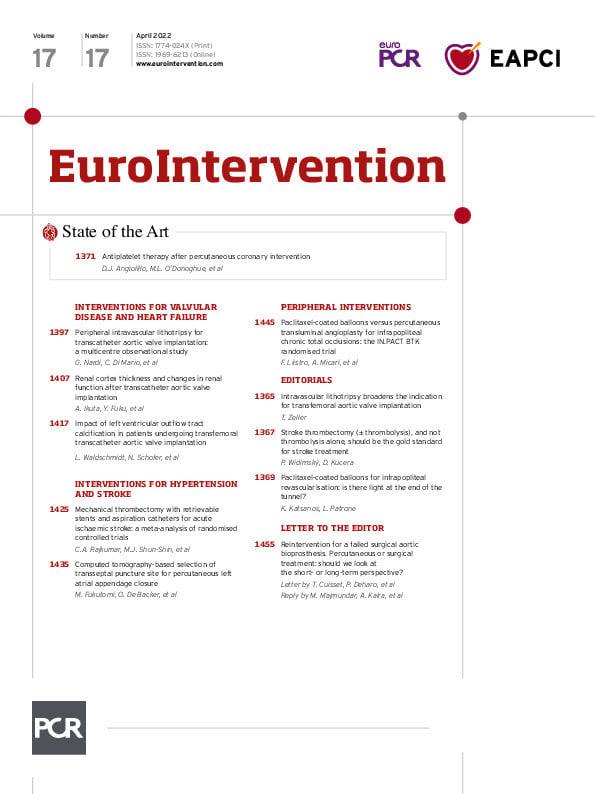In this issue of EuroIntervention, Liistro et al report the 9-month results from the IN.PACT BTK study, which was a multicentre randomised pilot study revisiting the concept of paclitaxel-coated balloon treatment for infrapopliteal revascularisation1. The investigators explored the use of a redesigned IN.PACT balloon catheter dedicated for the infrapopliteal arteries and randomised 50 critical limb ischaemia (CLI) patients suffering from long arterial occlusions below-the-knee that exceeded 21 cm on average. The team of investigators is to be commended on the challenging inclusion criteria that limited enrolment to chronic total occlusions alone with a background of numerous severe comorbidities that are routinely recognised in a CLI patient population.
The study was focused on testing drug-device efficacy in inhibiting vascular restenosis and the primary outcome was set at late lumen loss (LLL) evaluated angiographically at 9 months in two different ways1. First, in the classical angiographic method, and second, in a subsegmental approach where each lesion is subdivided into 10 discrete, consecutive segments that are analysed separately and averaged to provide a mean LLL value per individual index lesion. This is certainly innovative and deserves particular attention in the field of research of drug-coated devices in the peripheral arteries that often present with long, diffuse complex lesions.
Albeit a pilot study, the IN.PACT BTK showed a borderline significant effect. The 9-month angiographic LLL was 0.892±0.774 mm for paclitaxel and 1.312±0.720 mm for the percutaneous transluminal angioplasty (PTA) group (p=0.070) in a classical analysis; it was 0.592±0.944 mm for drug-coated balloon (DCB) and 1.260±0.810 mm for PTA (p=0.017) in a subsegmental analysis1. There were no red flags in the rest of the secondary safety endpoints, but the study was a small pilot trial and was certainly underpowered to test any clinically relevant outcome measures. Long-term follow-up is ongoing. The aforementioned angiographic results are somewhat encouraging and point to some light at the end of the tunnel following previously published negative outcomes from several other major randomised trials in the same field, e.g., the IN.PACT DEEP, the BIOLUX PII and more recently the Lutonix BTK trials2.
Still, there have been concerns about the long-term risk of all-cause death with the use of paclitaxel-coated devices in the femoropopliteal arteries for treatment of intermittent claudication3, and more recently, about the long-term risk of major amputations with the use of paclitaxel-coated balloons, particularly in the case of CLI4. The jury is still out on paclitaxel, but unfortunately, randomised controlled trials on femoropopliteal and infrapopliteal are yet to document a formal clinical benefit for the CLI patient subset, e.g., improved wound healing or limb salvage.
Distal embolisation of paclitaxel particulate material has been put forward as the overarching hypothesis for the observed amputation risk. It has been long known that less than 10% of the paclitaxel load is transferred to the vessel wall layers and up to 90% escapes into the distal microcirculation4. Paclitaxel tissue bioavailability is governed by a complex and fascinating interplay of paclitaxel crystallinity, the dissolution kinetics of individual excipients, the expression levels of tissue paclitaxel binding sites, and mechanical diffusion barriers like calcifications5. Still, two separate randomised studies have demonstrated comparable clinical results in patients with calcified infrapopliteal arteries who were randomly allocated between atherectomy combined with drug-coated balloons versus DCB angioplasty alone67.
Hence, safety and efficacy may vary between vascular territories, depending on the underlying atherosclerosis and background cardiovascular risk. Still, the authors maintain the opinion that newer generations of DCB based on novel designs (nano- or micro-crystalline paclitaxel), preferably low-dose formulations, and alternative agents like sirolimus or everolimus, will pave the way for a bright future of DCB therapies in the lower limbs. The IN.PACT BTK trial exhibits a brave design and will hopefully keep the momentum going for more large-scale randomised trials in the challenging infrapopliteal landscape.
Conflict of interest statement
K. Katsanos declares grants and/or contracts from Medalliance, Rontis and Medtronic; and is an investigator for the IN.PACT BTK study. L. Patrone declares consulting fees from Abbott, Cook, Cordis, Pathfinder Medical, Shockwave and Terumo.
Supplementary data
To read the full content of this article, please download the PDF.

